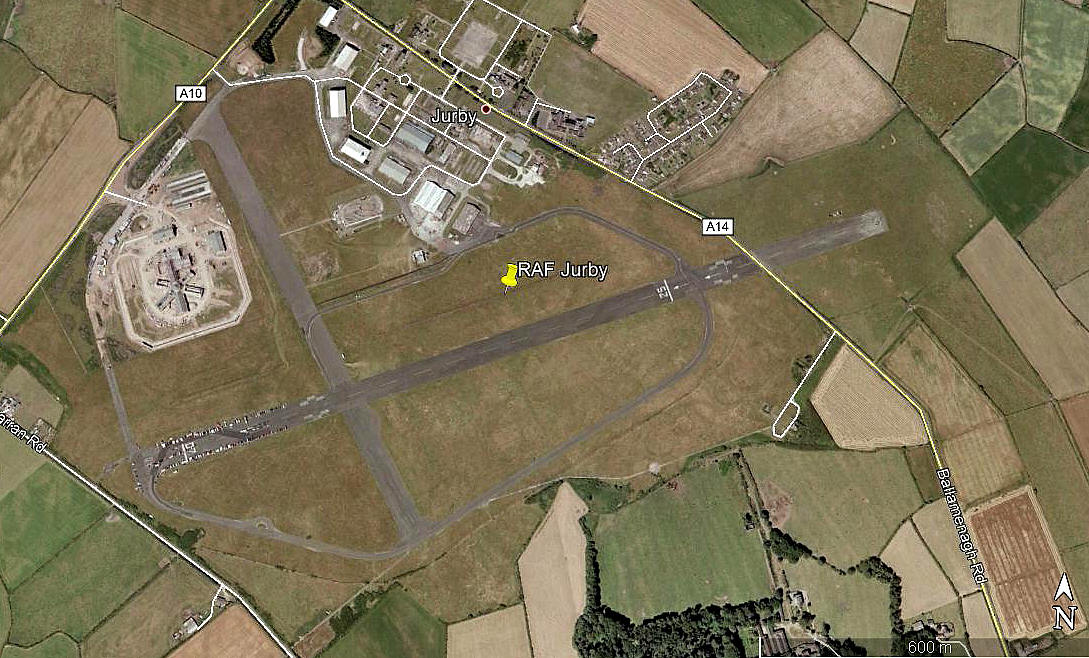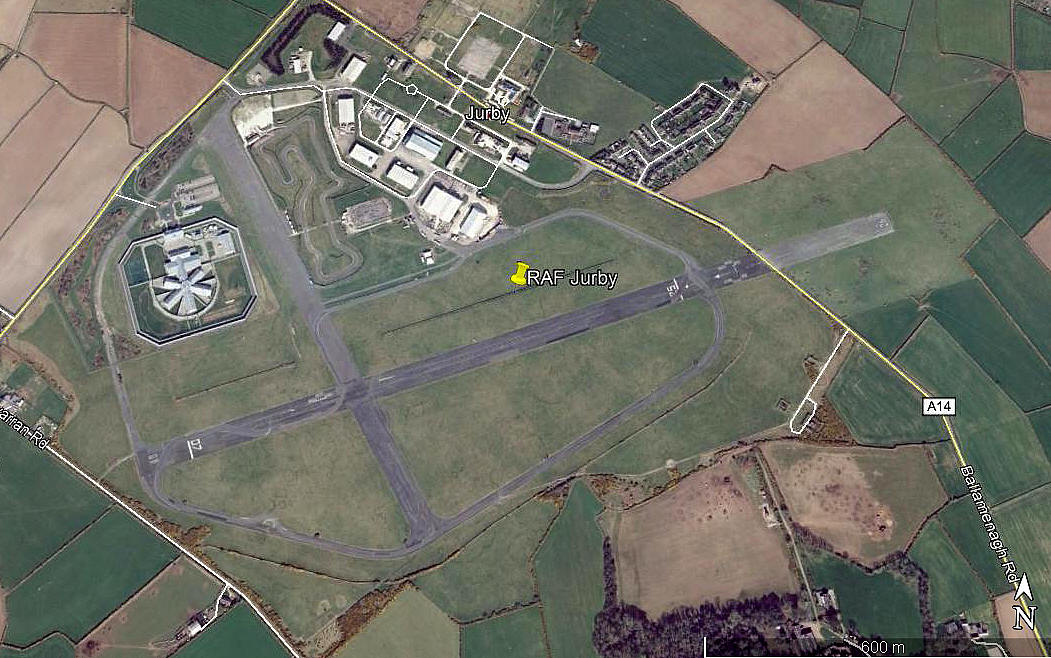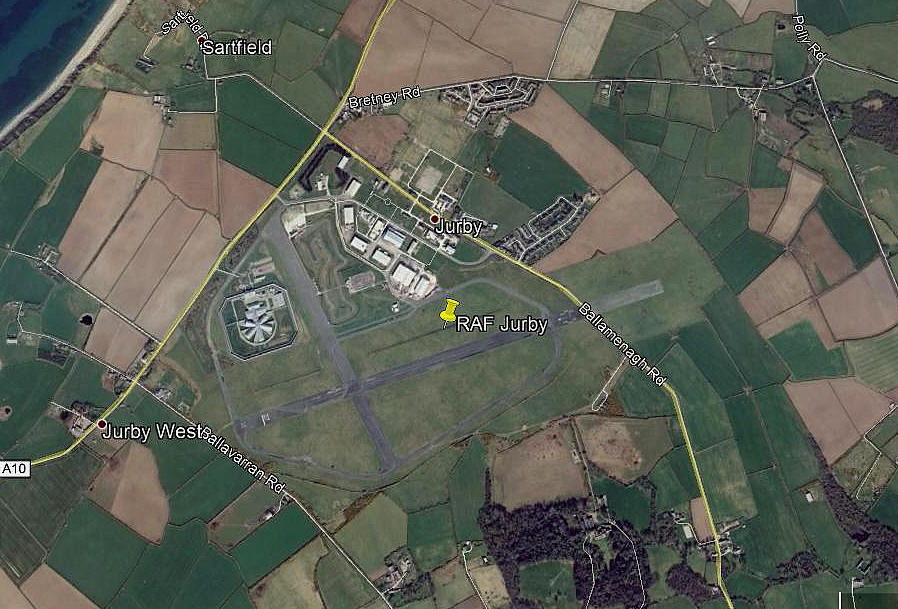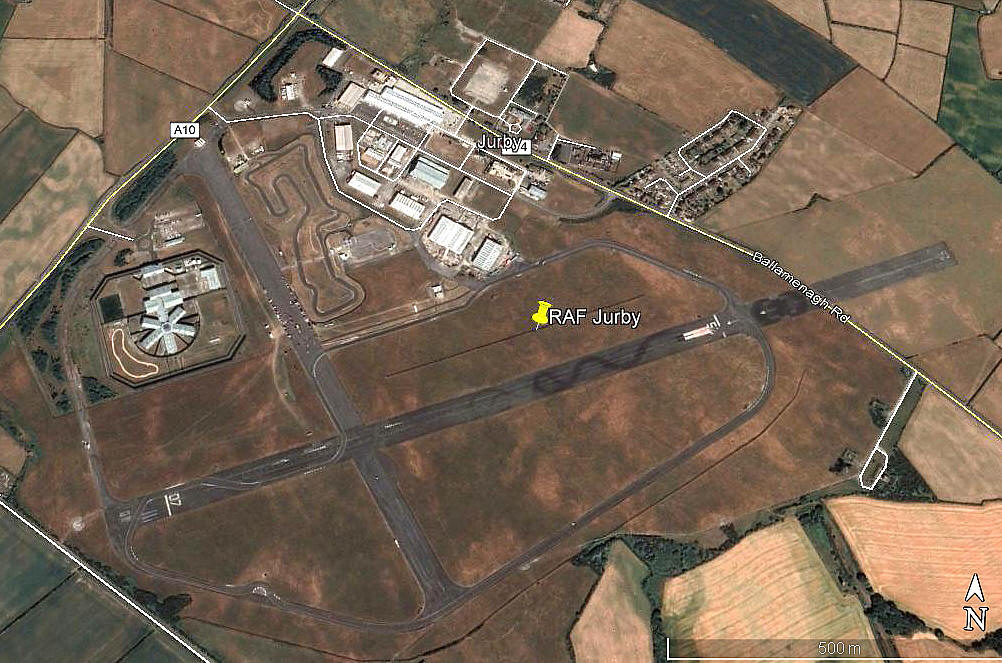Jurby
JURBY: Military aerodrome (Later civil airfield)
Note: These pictures were obtained from Google Earth ©
Militarys users: WW2: RAF Flying Training Command 29 Group
SAOS according to one account - but I can find no record appertaining. I suspect this could be SofAS (?) - School of Air Support
5 BGS [Bombing & Gunnery School] This appears to have had a motley selection of aircraft including: (Bristol Blenheims, Fairey Battles, Hawker Henlys and the Westland Wallace type)
No.5 Air Navigation & Bombing School [From May 1945] (Avro Ansons & Vickers Wellingtons)
RAF Fighter Command
258,302 (Polish) & 312 Sqdns (Hawker Hurricanes)
307 (Polish) Sqdn (Boulton Paul Defiants)
457 Sqdn (Vickers-Supermarine Spitfires)
Location: SE of Sartfield village, E of A10 & N of B5 roads, 5nm WNW of Ramsey
Period of operation: Military: 1939 to 1972
Note: Apparently listed as being civil and, from 1965 at least, until 1977 (?), as being a Diversion airfield for RONALDSWAY.
Note: This map is kindly reproduced with the kind permisission of Pooleys Flight Equipment. Copyright Robert Pooley 2014.
Runways: WW2: 08/26 1097x46 hard 16/34 914x46 hard
1965: 08/26 1463x46 hard 16/34 905x46 hard
2012: 07/25 935 hard
Note: As the pictures above show, the 07/25 (08/26) runway has not always been available for GA (General Aviation) use.
NOTES: The fact that two Polish squadrons were based here for a while makes a convenient excuse to explain that during WW2 the RAF had fifteen Polish squadrons and their best pilots and aircrews were ranked amongst the finest. However, despite the invasion of Poland being the reason that the UK declared war on Nazi Germany, Polish pilots and aircrew who had managed to escape were often treated abysmally by the RAF initially and it took rather a long time before their true abilities were recognised.
Indeed, in Fighter Command especially their general approach to combat and ruthless techniques were ground breaking and made an inestimable contribution, especially during the ‘Battle of Britain’ phase. As pointed out elsewhere it is quite reasonable today to argue that the extent of their contribution can never be quantified. But, without them it is argued today, we’d almost certainly have lost the ‘Battle of Britain’?
Please look at my article regarding the “so called” Battle of Britain. The threat of an invasion was certainly real enough for one brief period, but the possibility of this ever happening was zilch. It could never have succeeded. The Royal Navy would have obliterated most of such an invasion force well before it reached our shores without any help from the RAF. And of course, during daylight hours, the RAF retained air superiority. Plus by then, the shore defences had been built up to a considerable extent.
It is often overlooked that an invasion by sea is very costly, in both men and equipment. It needs to be remembered that during the D-Day invasion for example, the Allied forces had almost complete air and naval command of the area, but, as we know, the attrition rate for troops invading those beaches, and airborne troops, was appalling.
A BUSY PLACE
Evidently a pretty busy place in 1944 with 2154 RAF & 194 WAAF personnel based here.
ANOTHER NEW ASPECT
It appears the first ‘F1”, (Formula 1), Air Race in Europe (?) took place here in 1970 and perhaps more significantly the King’s Cup Race was held here on the 9th September 1979, clearly indicating that JURBY was, (probably?) still operational. There has been no evidence of the King’s Cup Air Race in its ninety-one year history (as of 2013) ever being held at a disused and unlicensed airfield.
The winner that year was Mr Ian Dalziel flying the Miles M.3A Falcon Major G-AEEG, one of twenty-five aircraft competing, at an average speed of 136.3mph. This is surely the best aspect of the annual King’s Cup Race, it being a handicapped race, whereby piloting abilities and aircraft preparation come to the fore. This example of the Miles M.3A Falcon Major first flew in 1934!
MODEL FLYING
In more recent years JURBY has also been used for model flying by Manx Model Flyers.
We'd love to hear from you, so please scroll down to leave a comment!
Leave a comment ...
Copyright (c) UK Airfield Guide




















